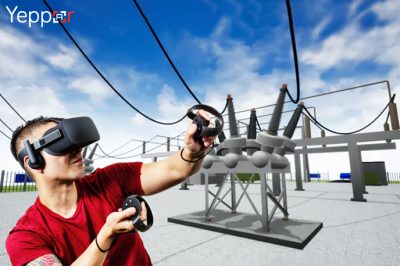While some people still think that VR is reserved for gaming purposes only, many are substantially noticing the implementation of Virtual Reality technology in a variety of other sectors. VR is swiftly turning into the go-to training solution for almost all of the various industries. And especially, when it comes to training employees for dangerous operations, VR is effectively proving its potential to become an efficient training tool. And as things go, training is becoming one of the most significant use cases for virtual reality in the power sector. VR can benefit electric power stations immensely by providing immersive workforce training and education solutions. The power sector has been one of the slow adopters of virtual reality technology, as it mostly relies on the traditional methods for carrying out its standard operations.
And as things go, training is becoming one of the most significant use cases for virtual reality in the power sector. VR can benefit electric power stations immensely by providing immersive workforce training and education solutions. The power sector has been one of the slow adopters of virtual reality technology, as it mostly relies on the traditional methods for carrying out its standard operations.
However, companies are now taking significant steps in enhancing their development and learning methods through VR technology. In this resource, let us understand some of the benefits of using Virtual Reality Technology in the field of electric substations:
VR Training Benefits at Electric Power Stations
- Improves Safety and Reduces Risk: Virtual reality training at electrical substations teaches how to handle equipment both during emergency situations and while performing everyday activities. VR training provides real-time, visual, and simple to follow instructions. Workers can get familiar with the operations and equipment due to realistic 3D immersive technology.
This enhances the safety element and trains employees to prevent breakdowns and manage troubleshooting equipment problems. Furthermore, the risk factor to both the operators and the machines are reduced as workers refine their skills for performing certain operations in the virtual world to help them relevantly handle the real-world dangerous situations.- Familiarity with Equipment: While improving their skills and the ability to operate, virtual reality training familiarizes workers with the equipment and machines, including its features and parts. It is always beneficial for the operators to familiarize themselves with the machines before using them on the field.
For example, workers must be trained to learn about the isolation procedures to power down a part of the electrical installation in case of an electrical fault. When the learning context in a training program is similar to that of the work context, it becomes easy to apply the skills and knowledge effectively. This mitigates the risk factor to a huge extent. - Learning Environment: It is very difficult to reproduce complex work situations for training. Virtual Reality training easily simulates the work environment anywhere. It is simple to create a 3D simulation of the entire electrical substation. This enables the workers and operators to conduct training in realistic 3D situations that can’t otherwise be easily created with such ease. It also helps you access information more clearly while preserving your focus in reality.
- Manage Emergencies: Through VR training, operators learn how to operate and troubleshoot equipment in case of an emergency such as an electrical fault that puts the whole installation at risk. Such situations can be simulated and operators can be made to resolve the technical issues and even communicate with virtual factory managers or unit directors. It helps in decreasing the communication errors. While training in a VR, operators can make errors and try different solutions to the issues without ensuing in real-life hazardous consequences. This builds up confidence among operators to perform accurate actions in real-life scenarios.
Conclusion
Virtual Reality technology is a great tool for training operators and to familiarize them with Electrical Substations’ equipment and machines. It gives them an understanding and pares
- Familiarity with Equipment: While improving their skills and the ability to operate, virtual reality training familiarizes workers with the equipment and machines, including its features and parts. It is always beneficial for the operators to familiarize themselves with the machines before using them on the field.













